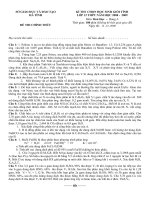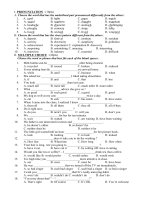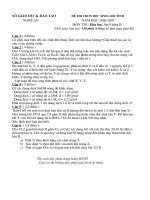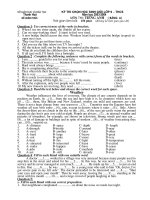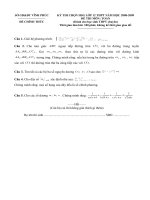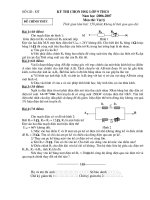BT doc hieu hsg tinh lop 9
Bạn đang xem bản rút gọn của tài liệu. Xem và tải ngay bản đầy đủ của tài liệu tại đây (97.71 KB, 5 trang )
<span class='text_page_counter'>(1)</span>HEDGEHOGS THREATEN WILDLIFE There are so many threats to the wildlife on our planet nowadays that we are rarely surprised when we are (1) .............. about another one. (2) .............., some people might find it difficult to (3) ..............that small creatures (4) ..............hedgehogs would be the cause, rather than the victims, of one of these threats. One resident of an island which (5) ..............off the west coast of Scotland (6) ..............how this extraordinary situation has come about. It appears that hedgehogs are not native to the islands. They were introduced by a gardener who thought they (7) ..............be an effective way of controlling the slug population. There are now so (8) ..............hedgehogs on the island that they are putting many rare birds at (9) ..............because they eat birds’ eggs. The hedgehogs, it seems, are (10) .............. , so what are the local people going to do (11) .............. it ? One group of conservationists tried to transport hedgehogs to the mainland. The plan might have (12)…………if residents on the mainland hadn’t pointed out that the hedgehogs would (13)…………just as much of a threat on the mainland as on the island. But, unless action is (14) …………soon, the continuing increase in the hedgehog population will (15) …………in the disappearance of certain rare species of birds. 1. A. mentioned B. explained C. told D. said 2. A. Even B. Although C. Yet D. However 3. A. believe B. convince C. suppose D. consider 4. A. so B. such C. like D. as 5. A. extends B. lies C. covers D. stretches 6. A. described B. commented C. talked D. meant 7. A. should B. can C. ought D. would 8. A. largely B. much C. many D.far 9. A. danger B. risk C. trouble D. difficulties 10. A. anywhere B. everywhere C. anything D. nothing 11. A. with B. about C. to D. for 12. A. beaten B. won C. caught D. succeeded 13. A. change B. become C. return D. move 14. A. made B. done C. taken D. held 15. A result B. lead C. cause D. turn 1. 2. 3. 4. 5. 6. 7. 8. 9. 10. 11. 12. 13. 14. 15. C. D. A. C. B. A. D. C. B. B. B. D. B. C. A. WALT DISNEY There is no one who has not heard of Walt Disney; he is without (0) B one of the most famous figures in the twentieth century and (1) ..................... most people know hardly anything about him. (2) ..................... he became one of the most successful men in history, he (3) ..................... school at the age of sixteen and then studied art for a short time. By the.
<span class='text_page_counter'>(2)</span> (4) ..................... years of this century, he had (5) ................. started to produce cartoons in Hollywood in (6) ..................... with his brother Roy, who, is for some reason, never (7) ..................... to become as famous as Walt. Disney is perhaps most well known on (8) ..................... of his lovable cartoon character, Mickey mouse, who first (9) ..................... in 1928 in a film called Steamboat Willie. One of the most (10) ..................... cartoon films of all time is Snow White and the Seven Dwarfs, which when it was (11) ..................... in 1937, was the first full-length cartoon in the history of the cinema. (12) ..................... the 1950s, Walt Disney had become one of the world's major (13) ..................... of films for cinema and television. As Disney Productions (14) ....................., its founder retained complete artistic control of the films and he also (15) ..................... on to publish books for children and cartoon strips in newspapers, featuring such characters as Donald duck and Pluto the dog. 0. A. comparison 1. A. yet 2. A. Despite 3. A. graduated 4. A. primary 5. A. still 6. A. partnership 7. A. achieved 8. A. case 9. A. appeared 10 A. common 11 A. seen 12 A. Until 13 A. businessmen 14 A. grew 15 A. took 1 A. 2 C. 3 C. 4 B. B. doubt B. then B. In spite of B. completed B. early B. soon B. friendship B. reached B. account B. performed B. excited B. released B. Since B. owners B. enlarged B. put 5 D. 6 A. 7 D. C. disagreement C. already C. Although C. left C. beginning C. yet C. relationship C. succeeded C. view C. starred C. popular C. circulated C. By C. publishers C. increased C. pushed 8 B. 9 A. 10 C. D. explanation D. however D. even D. failed D. initial D. already D. membership D. managed D. regard D. began D. known D. advertised D. To D. producers D. succeeded D. went 11 B. 12 C. 13 D. 14 A. A pioneering study by Donald Appleyard made the astounding discovery that a sudden increase in the volume of traffic through an area affects people in the way that a sudden increase in crime does. Appleyard observed this by finding three blocks of houses in San Francisco that looked much alike and had the same kind of middle-class and workingclass residents, with approximately the same ethnic mix. The difference was that only 2,000 cars a day ran down Octavia Street (LIGHT street, in Appleyard’s terminology) while Gough Street (MEDIUM street) was used by 8,000 cars daily, and Franklin Street (HEAVY street) had around 16,000 cars a day. Franklin Street often had as many cars in an hour as Octavia had in a day.. 15 D.
<span class='text_page_counter'>(3)</span> Heavy traffic brought with it danger, noise, fumes and soot, directly, and trash secondarily. That is, the cars didn’t bring in much trash, but when trash accumulated, residents seldom picked it up. The cars, Appleyard determined, reduced the amount of territory residents felt responsible for. Noise was a constant intrusion into their homes. Many Franklin Street residents covered their doors and windows and spent most of their time in the rear of their houses. Most families with children had already left. Conditions on Octavia Street were much different. Residents picked up trash. They sat on their front steps and chatted with neighbors. They had three times as many friends and twice as many acquaintances as the people on Franklin. On Gough Street, residents said that the old feeling of community was disappearing as traffic increased. People were becoming more and more preoccupied with their own lives. A number of families had recently moved and more were considering. Those who were staying expressed deep regret at the destruction of their community. 1. The word “astounding” in line 1 is closest in meaning to __________. A. startling B. disappointing C. dubious D. alternative 2. The three streets mentioned in this passage are different in that __________. A. they are in different cities. B. the residents are of different ethnic backgrounds. C. they have varying amounts of traffic. D. the income levels of the residents vary considerably. 3. Approximately how many cars used Franklin Street daily? A. 2,000 B. 8,000 C. 16,000 D. 20,000 4. All of the following are direct results of heavy traffic EXCEPT __________. A. increased amount of trash B. greater danger to residents C. more pollution D. more vibrations 5. The author’s main purpose in the second paragraph is to __________..
<span class='text_page_counter'>(4)</span> A. discuss the problem of trash disposal B. point out the disadvantage of heavy traffic C. propose an alternate system of transportation D. suggest ways to cope with traffic problems 6. On which street was there the most social interaction? A. Octavia Street B. Gough Street C. Franklin Street D. There was no significance social interaction on any of the three streets 7. The word “chatted” in line 14 is closest in meaning to __________. A. joked B. talked C. argued D. walked 8. Which of the following is NOT a statement you would expect from a resident of Gough Street? A. People on this street are unhappy because the neighborhood is deteriorating. B. People on this street think mostly of themselves. C. People on this street have more and more space for which they feel responsible. D. A number of people are preparing to leave this street. 9. In what order does the author present detailed discussions of the three streets? A. LIGHT, MEDIUM, HEAVY B. HEAVY, MEDIUM, LIGHT C. HEAVY, LIGHT, MEDIUM D. LIGHT, HEAVY, MEDIUM 10. What is the writer’s attitude toward heavy traffic when he mentions the Appleyard’s study? A. neutral B. favorable C. critical D. doubtful. 1.A 2.C 3.C 4.A. 6.A 7.B 8.C 9.C.
<span class='text_page_counter'>(5)</span> 5.B. 10.C.
<span class='text_page_counter'>(6)</span>
